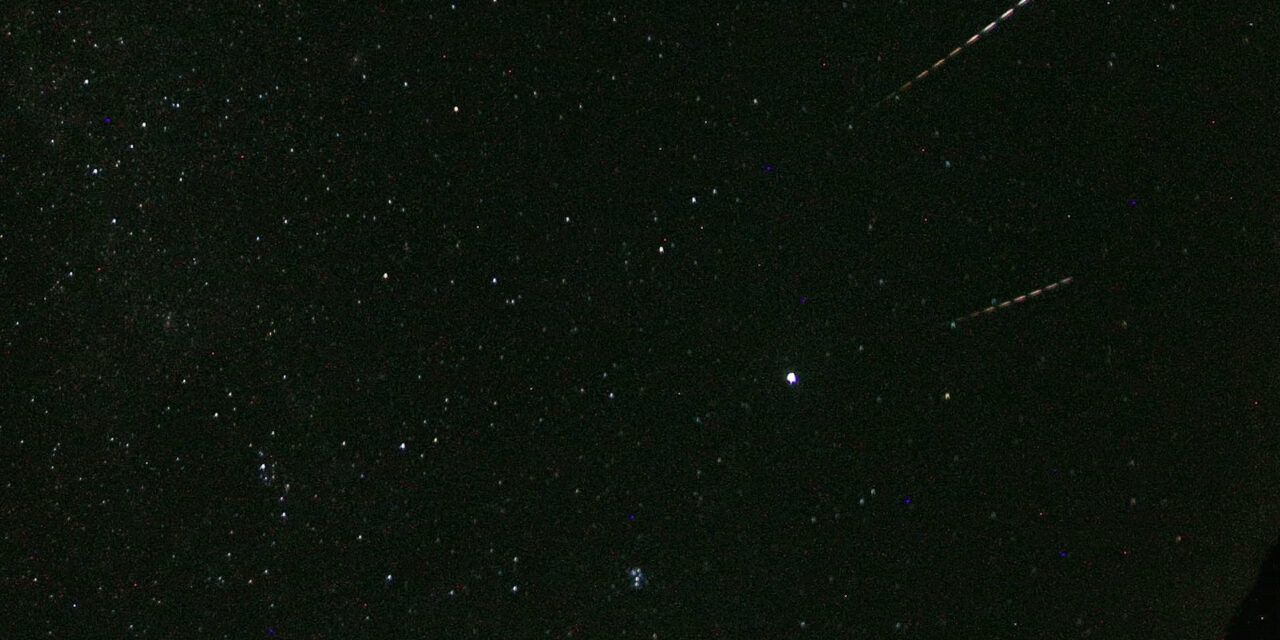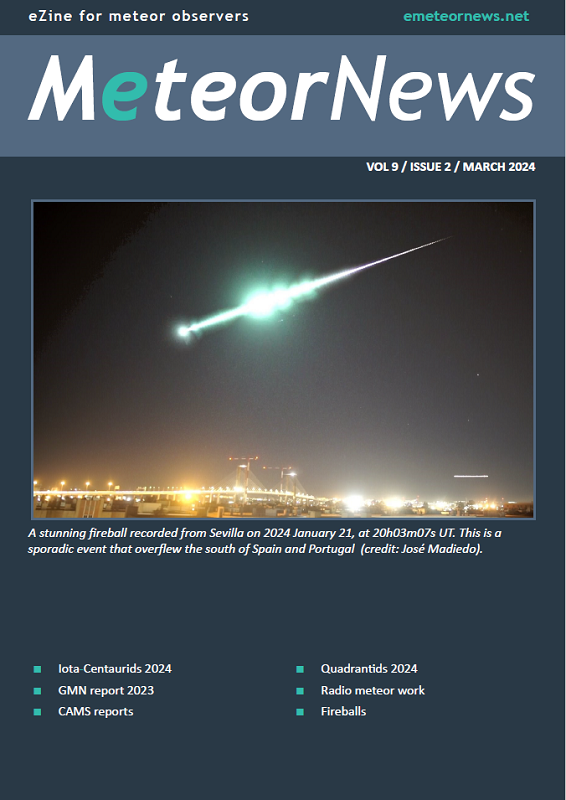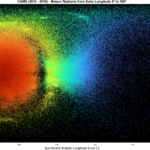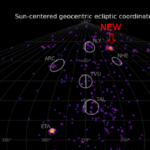Composite image of two Perseid fireballs that appeared in quick succession at 02:06 UT (-5 Perseid in Cetus) and 02:30 UT (-6 Perseid in Pisces). These Perseids appeared in the interval of the predicted dust trail passage of comet 109P/Swift-Tuttle of 68 BC. Camera and lens: Canon 6D with Sigma 8mm F3.5 EX DG Circular Fisheye lens with built in Liquid Crystal Shutter set at 16 breaks per second. (c) Koen Miskotte.
The visual observations analyzed by the author confirm the enhanced activity reported earlier by radio observers at at λʘ = 140.82. The observations by European observers show relatively many bright Perseids, especially between λʘ = 140.57° and λʘ = 140.77°. This coincides with the expected activity of the old 68 BC dust trail between λʘ = 140.70° and λʘ = 140.77°.
1 Introduction
Just as in previous years, 2018 (Miskotte, 2019a; 2019b), 2019 (Miskotte and Vandeputte, 2020a; 2020b), 2020 (Miskotte, 2020a; 2020b; 2020c; 2021) and 2021 (Jenniskens and Miskotte, 2021; Miskotte et al., 2021a; 2021b), an outburst of the Perseids has been observed this year, more than 24 hours after the annual maximum (Roggemans, 2023; Sugimoto and Ogawa, 2023). The IMO Meteor Shower Calendar 2023 also stated that in addition to the chance for a recurrence of the outburst from previous years, there was also a chance of some extra activity due to an old dust trail and a filament. On August 13, 2023 around 3h UT (λʘ = 139.83°) the Earth would pass through a weak filament according to Peter Jenniskens. And on August 14, 2023 between 01h00m and 02h45m UT (λʘ = 140.74), Earth would pass through an old dust trail from comet 109P/Swift-Tuttle from 68 BC predicted by Jérémie. Vaubaillon. Forced by circumstances, the author decided to use a limited data set and do some preliminary calculations to see if the features mentioned in the Meteor Shower Calendar were effectively observed.
2 Perseid outburst?
The annual Perseid ZHRr curve has again been published on the website of the Japanese radio observer Hirofumi Sugimoto. How these ZHR calculations are achieved is explained in Sugimoto (2017). The 2023 ZHR curve shows that there was an outburst around solar longitude 140.81° with a peak ZHRr of 160. Radio observations have also been published in Sugimoto and Ogawa (2023). In the meantime, the author had also received a message from Pierre Martin from Canada who wrote: “I had to drive nearly 1000km (!!!) to find clear skies on August 12–13 further south in Ontario, due to unstable weather. I was in a good position for the traditional maximum and it appears it was a normal level one, or maybe a bit below normal. On Sunday, my friend and I drove all the way back home. I then had clearing skies much closer to home in the evening of August 13–14 after a rainfall. I was aware of the possibility of a dust trail prediction, for the hours before midnight. So, I rushed to go to my dark sky site and setup soon after dark. Even though the radiant was still low I could see a good number of Perseids shooting in different directions without even trying to see them. Some long and bright! Unfortunately, clouds covered the sky and I had to wait until nearly midnight for it to clear again. Then I had only a few minor spells of thin patchy clouds in an otherwise very transparent sky. The meteor activity was very nice the rest of the night. The Perseids continued to do a good appearance with rates approaching one per minute I think and many bright long ones, with a few –3s and a –4. Also had a nice variety of other meteor sources… kappa Cygnids, Aquariids and eta Eridanids. The best meteor was a gorgeous very slow sporadic earth-grazer low in the north, moving from west to east, that reached –4 and lasted 7–8 seconds!! Then it fragmented in 3–4 pieces!!”.
This looks like there was significantly increased Perseid activity.
 Figure 1 – The Perseid ZHRr curve[1] from the website of Hirofumi Sugimoto
Figure 1 – The Perseid ZHRr curve[1] from the website of Hirofumi Sugimoto
[1] http://www5f.biglobe.ne.jp/~hro/Flash/2023/PER/index-e.htm
3 The used visual data
In the article by Sugimoto and Ogawa (2023) one of the conclusions states: “The third peak had its maximum with AL(max) = 1.2 at λʘ = 140.84° (August 14, 4h30m UT) (Comp.3). According to Vaubaillon as mentioned in the Meteor Shower Calendar published by IMO that a very old dust trail released in 68 BC may be encountered around λʘ = 140.74° (between 01h and 02h45m UT on August 14). Although the observed enhancement in activity was later than this prediction, it is possible that this activity was caused by this old trail. However, on the other hand, it is also possible that this third peak is related to the secondary peak around λʘ = 140.5°–141.6° which was observed in previous years. It is very difficult to know whether or not an old dust trail and an unexpected peak activity are somehow related to the secondary peak observed in past years”.
In short: it is therefore unclear whether the observed radio peak is caused by the old dust trail from 68BC or whether it is the well-known “new” peak around solar longitude 141°. This was the reason to look into the available visual data. The time interval of Pierre Martin’s meteor watch is from 03h08m to 08h55m UT. The IMO website has been checked to see if there were more observers active in Pierre Martin’s interval, but unfortunately, he is the only observer active in that period. There is a small amount of overlap at the start of his observations with the observations of Michel Vandeputte and the author from Revest-du-Bion, France. And at the end of his session there is some overlap with observations from Terrence Ross from Texas, US. Because of lack of time the author made an analysis with the observations of Pierre Martin, supplemented with data from Michel Vandeputte (south of France), Koen Miskotte (south of France), Ina Rendtel (Germany), Javor Kac (Slovenia) and Kai Frode Gaarder (Crete, Greece).
The population index r was determined hourly based on two-hour periods. The ZHR was determined based on periods of 15 to 25 minutes, but some periods of Pierre Martin’s data were shorter. A weighted average was used for the final ZHR determinations.
4 Another Perseid outburst
Table 1 and Figure 2 could be created from Pierre Martin’s data. This clearly shows that an outburst was going on at λʘ = 140.82 (14 August 2023 at 04h00m UT). The highest ZHR is 167 ± 39. Added to this is the radio ZHRr graph from Sugimoto and Ogawa (2023). This graph was created from radio observations collected by RMOB. Please note: the two observation techniques cannot be compared with each other, but it has only been used here to see if there are similarities. That is clearly the case because the radio observers had their highest activity exactly around Pierre Martin’s highest ZHR. His observation is therefore a nice confirmation and valuable addition to the radio data.
The population index r at the time of the peak was r[–2;5] = 2.13 ± 0.26. This is a fairly normal value for the Perseids and therefore does not indicate old material such as the old dust trail from 68BC should contain. We would expect relatively many bright meteors from an old dust trail and thus a lower population index r. It is therefore more likely that this was a new occurrence of the (now almost annual) second maximum around λʘ = 141.0°. It is also striking that the Perseid activity appears to have increased during Pierre Martin’s entire observational session. The high population index r at the end of its observation session is mainly due to the many +5 Perseids. Table 2 provides a comparison between the peaks found in the period 2018–2023 in terms of ZHR and population index r.
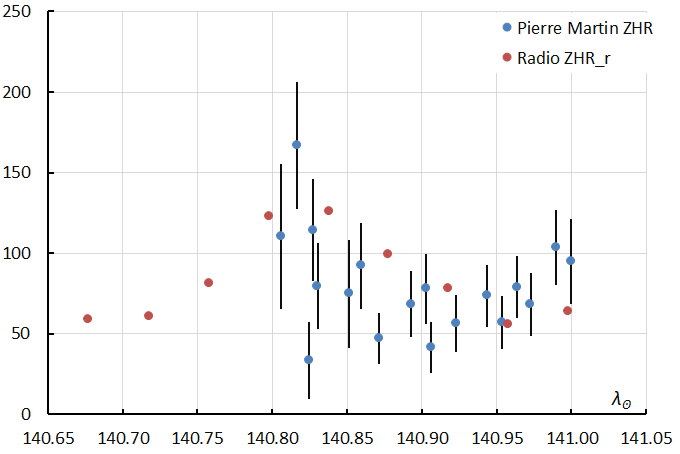 Figure 2 – Observed visual ZHR of Pierre Martin compared to the radio ZHRr based on RMOB data for August 13–14, 2023.
Figure 2 – Observed visual ZHR of Pierre Martin compared to the radio ZHRr based on RMOB data for August 13–14, 2023.
Table 1 – Observed ZHR values by Pierre Martin from Canada, all on 2023 August 14.
|
Time UT |
λʘ (°) |
ZHR |
± |
|
3.733 |
140.806 |
110 |
45 |
|
4.000 |
140.817 |
167 |
39 |
|
4.200 |
140.825 |
34 |
24 |
|
4.270 |
140.827 |
114 |
32 |
|
4.345 |
140.830 |
80 |
27 |
|
4.867 |
140.851 |
75 |
33 |
|
5.067 |
140.859 |
92 |
27 |
|
5.375 |
140.872 |
47 |
16 |
|
5.908 |
140.893 |
68 |
21 |
|
6.158 |
140.903 |
78 |
22 |
|
6.242 |
140.906 |
42 |
16 |
|
6.658 |
140.923 |
56 |
18 |
|
7.175 |
140.944 |
73 |
19 |
|
7.425 |
140.954 |
57 |
17 |
|
7.675 |
140.964 |
79 |
19 |
|
7.900 |
140.973 |
68 |
20 |
|
8.325 |
140.990 |
104 |
23 |
|
8.575 |
141.000 |
95 |
26 |
Table 2 – Comparing the outbursts at λʘ = 141° during the years 2018, 2019,2020, 2021, 2022 and 2023.

But the question remains, was there extra Perseid activity from the 68 BC dust trail of 109/P?
We assume that the peak at λʘ = 140.82° (14 August 2023 at 04h00m UT) may have been caused by the same structure that was active in 2018, 2019 and 2021. The question then remains: was the dust trail from 68 BC active? According to J. Vaubaillon, the dust trail was expected on August 14, 2023 between 01h00m and 02h45m UT (between λʘ = =140.70° and λʘ = =140.77°) and ideal for Europe. Calculations based on the data of the five European observers mentioned above resulted in Table 3 and Figure 3. The ZHR plot shows a decreasing activity, see the trend line. This is something you would expect in a “normal” Perseid year. ZHR’s in de order of 60–80 slowly decreasing to 50–60. That seems “slightly” on the high side for this period.
What is striking is the low population index r (see Table 3) in the period from λʘ = 140.57° to λʘ = 140.77°. This also covers the interval that Vaubaillon specifies for the 68BC dust trail between λʘ = 140.70° and λʘ = 140.77°, see Table 3. The five observers also reported many bright Perseids on this night, especially in the second part. And four of the five also reported multiple Perseid fireballs in the –3 to –6 class. In Figure 4 we see all ZHR values combined with the population index r in one graph. Both ZHR and population index as observed from Europe and US agree nicely with each other in terms of progression. With regard to the ZHR, it seems as if Europe may have just caught the start of the structure that has already been seen in 2018 and beyond (see the last data point in Figure 2). The orange points indicate the population index r[–2;5] based on Table 3. The conclusion of all this is that the dust trail of comet 109P/Swift-Tuttle from 68 BC appears to have been active before and during the predicted interval of J. Vaubaillon. Perhaps a slightly higher ZHR caused solely by the bright Perseids. This in combination with the annual activity gave a somewhat lower population index r than normal. And that is exactly what we would expect from such an old dust trail.
Table 3 – Population index r[-2;5] Perseids during August 13–14, 2023
|
Date |
Time UT |
λʘ (°) |
r[-2;5] |
± |
|
13/08/2023 |
21.25 |
140.547 |
2.05 |
0.14 |
|
13/08/2023 |
22.00 |
140.577 |
1.98 |
0.12 |
|
13/08/2023 |
23.01 |
140.617 |
1.93 |
0.11 |
|
14/08/2023 |
0.05 |
140.659 |
1.87 |
0.11 |
|
14/08/2023 |
1.10 |
140.701 |
1.88 |
0.1 |
|
14/08/2023 |
1.87 |
140.731 |
1.97 |
0.11 |
|
14/08/2023 |
2.75 |
140.767 |
2.04 |
0.23 |
|
14/08/2023 |
4.54 |
140.838 |
2.13 |
0.26 |
|
14/08/2023 |
5.54 |
140.878 |
2.24 |
0.28 |
|
14/08/2023 |
6.55 |
140.919 |
2.83 |
0.27 |
|
14/08/2023 |
7.50 |
140.957 |
3.00 |
0.22 |
|
14/08/2023 |
8.23 |
140.986 |
3.00 |
0.27 |
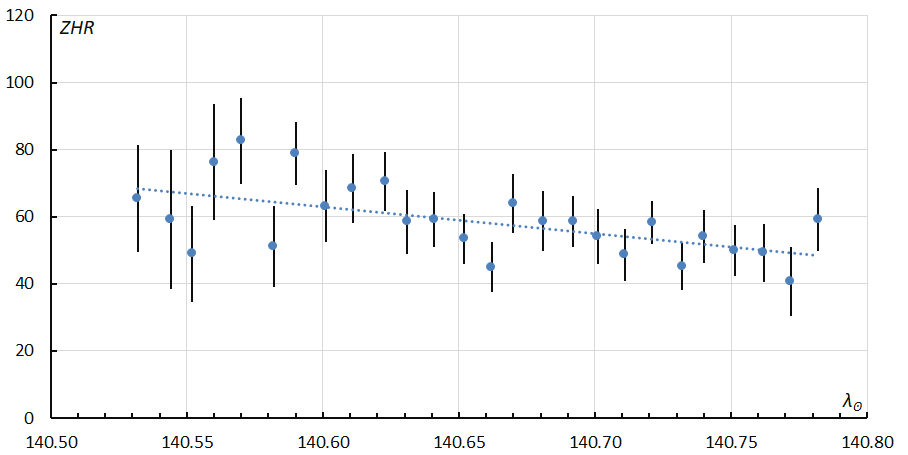
Figure 3 – Perseid activity as observed from Europe during the night of August 13–14, 2023.
Table 4 – ZHR of the Perseids over Europe on the night of August 13–14, 2023 based on data from 5 visual observers.
|
Day |
Time UT |
λʘ (°) |
ZHR |
± |
|
13 |
20.63 |
140.522 |
36 |
16 |
|
13 |
20.88 |
140.532 |
65 |
21 |
|
13 |
21.18 |
140.544 |
59 |
14 |
|
13 |
21.38 |
140.552 |
49 |
17 |
|
13 |
21.59 |
140.560 |
76 |
13 |
|
13 |
21.83 |
140.570 |
83 |
12 |
|
13 |
22.13 |
140.582 |
51 |
9 |
|
13 |
22.31 |
140.590 |
79 |
11 |
|
13 |
22.61 |
140.601 |
63 |
10 |
|
13 |
22.87 |
140.611 |
69 |
9 |
|
13 |
23.15 |
140.623 |
70 |
10 |
|
14 |
23.35 |
140.631 |
59 |
8 |
|
14 |
23.62 |
140.641 |
59 |
8 |
|
14 |
23.88 |
140.652 |
53 |
7 |
|
14 |
0.13 |
140.662 |
45 |
9 |
|
14 |
0.33 |
140.670 |
64 |
9 |
|
14 |
0.61 |
140.681 |
59 |
8 |
|
14 |
0.88 |
140.692 |
59 |
8 |
|
14 |
1.10 |
140.701 |
54 |
8 |
|
14 |
1.35 |
140.711 |
49 |
6 |
|
14 |
1.62 |
140.721 |
58 |
7 |
|
14 |
1.88 |
140.732 |
45 |
8 |
|
14 |
2.09 |
140.740 |
54 |
8 |
|
14 |
2.36 |
140.751 |
50 |
9 |
|
14 |
2.63 |
140.762 |
49 |
10 |
|
14 |
2.88 |
140.772 |
41 |
9 |
|
14 |
3.13 |
140.782 |
59 |
12 |
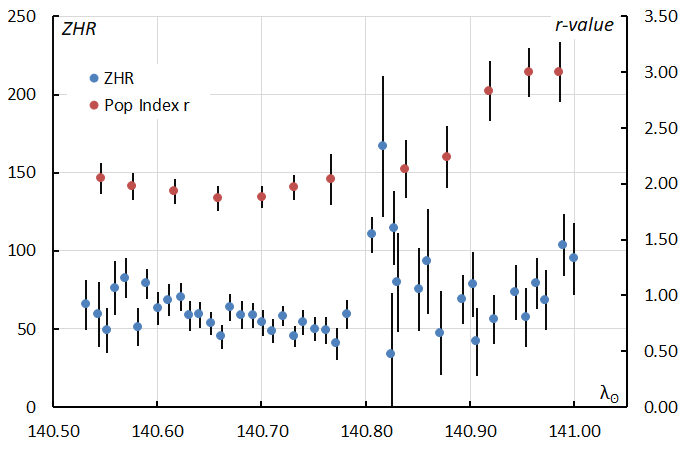
Figure 4 – Perseids ZHR and population index r between 13 August 20h UT and 14 August 09h UT.
5 Conclusion
The Perseid outburst observed by radio observers (Sugimoto and Ogawa, 2023) around λʘ = 140.84° has also been confirmed by the visual observations of Pierre Martin. His data shows a maximum at λʘ = 140.82° with a ZHR of 167 ± 39 and population index r = 2.13. This is in good agreement with the radio data. Most likely this was the occurrence of the new peak around λʘ = 141° showing a similar or lower population index r.
The dust trail of comet 109P/Swift-Tuttle from 68 BC may also have been active. The observations of five European observers show relatively many bright Perseids, especially between λʘ = 140.57° and λʘ = 140.77°. This coincides with the expected activity of the old 68 BC dust trail between λʘ = 140.70° and λʘ = 140.77°. The strikingly high number of very faint Perseids at the end of Pierre Martin’s session is also interesting enough for additional research.
Acknowledgment
Thanks to all observers who submitted data to the IMO website. This analysis used data from Kai Frode Gaarder, Javor Kac, Pierre Martin, Koen Miskotte, Ina Rendtel and Michel Vandeputte. A thank you for Hiroshi Ogawa and Hirofumi Sugimoto for providing the radio data, Carl Johannink and Michel Vandeputte for reading and commenting on this article.
References
Jenniskens P., Miskotte K. (2021). “Perseids meteor outburst 2021”. eMetN, 6, 260–261.
Miskotte K. (2019a). “Perseïden 2018: een analyse van de visuele waarneemdata”. Radiant, 41, 27–35.
Miskotte K. (2019b). “The Perseids in 2018 analysis of the visual data”. eMetN, 4, 135–142.
Miskotte K., Vandeputte M. (2020a). “Perseïden 2019 Opnieuw een piek in activiteit rond zonslengte 141,0?”. Radiant, 42, 100–103.
Miskotte K., Vandeputte M. (2020b). “Perseids 2019: another peak in activity around solar longitude 141.0?”. eMetN, 5, 25–29.
Miskotte K. (2020a). “Perseïden 2020: voor de derde keer een uitbarsting rond zonslengte 141° graden?”. Radiant, 42, 87–89.
Miskotte K. (2020b). “Perseids 2020: again, enhanced Perseid activity around solar longitude 141?”. eMetN, 5, 395–397.
Miskotte K. (2020c). “Perseids 2020 revisited”. Radiant, 42, 162–163.
Miskotte K. (2021). “Perseids 2020 revisited”. eMetN, 6, 29–30.
Miskotte K., Sugimoto H., Martin P. (2021a). “The big surprise: a late Perseid outburst!”. eMetN, 6, 517–525.
Miskotte K., Sugimoto H., Martin P. (2021b). “De Perseïden uitbarsting van 14 augustus 2021”. Radiant, 43, 51–58.
Roggemans, P. (2023). “Unusual Perseid activity in 2023”. eMetN, 8, 288–289.
Sugimoto H., Ogawa, H. (2023). “Perseids 2023 by worldwide radio meteor observations”. eMetN, 8, 285–287.
Sugimoto H. (2017). “The New Method of Estimating ZHR using Radio Meteor Observations”. eMetN, 2, 109–110.

